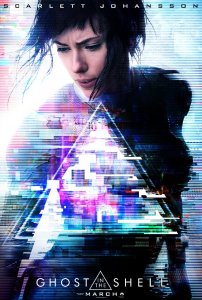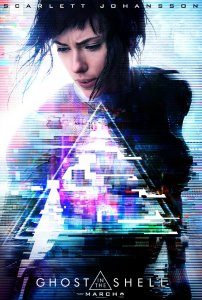Back to the Retrofuture, Version 2.0:A Review of Ghost in the Shell
by Gary Westfahl
One personal revelation garnered from watching the new, live-action version of Ghost in the Shell is that it is possible to admire a film without really liking it. Director Rupert Sanders and screenwriters Jamie Moss, William Wheeler, and Ehren Kruger have unquestionably crafted an intelligently-written, fast-paced, and visually stunning adventure, and as the events unfolded, I kept thinking that I should be enjoying the experience. Instead, I was longing for the movie to come to an end, and wondering why I felt that way.
Part of the problem, I think, involves the entire subgenre of cyberpunk, represented by writers like William Gibson and Bruce Sterling and by films like Blade Runner (1982), Johnny Mnemonic (1995), and this film’s uncredited precursor, Mamoru Oshii’s classic anime film Ghost in the Shell (1995). Despite all of the scholarly attention and praise that such writers and films have received, one might cynically epitomize the genre as routine cops-and-robbers stuff, with an overlay of portentous platitudes about the ways that new technology is erasing all traditional boundaries between fantasy and reality, human and nonhuman, and so on. And this film could serve as Exhibit A in support of this argument. Thus, we are told that protagonist Major (Scarlett Johannson) has a human brain inside a robot body, so that “the line between human and machine is blurring”; an African diplomat worries about the “risks to individuality” raised by humans with mechanical “augmentations”; the cyborg Major is told, “you are what everyone will become one day”; characters can never trust their own memories, as these might be false; and also living in a city filled with realistic holograms, Major’s partner Batou (Pilou Asbæk) concludes, “Fantasy, reality … what’s the difference? It’s all the same.” Yet what is actually going on in this film? We have some good guys, and some bad guys, and they engage in a series of bloody gun battles until the good guys finally win. And everything about these encounters is completely predictable to anyone who has seen contemporary films: that is, Major may be attacked by a dozen adversaries with machine guns, but she can always dance around and effortlessly dodge their hundreds of bullets while she picks them off one by one with her own, expertly aimed single shots. Thus, despite its veneer of futuristic novelty, the film is also a story that audiences have seen many, many times before.
It is also surprising to realize how dated this film’s concerns seem to be. Back in the 1980s, computers were new, robotics was in its infancy, and it was easy to anticipate – and fear – that these innovations would completely transform the human condition – so one might well, like the youthful runaways referenced in the film, “write manifestos about how technology is destroying the world.” Today, computers have been smoothly integrated into the social order, robots have not yet advanced in ways that threaten anyone’s sense of human identity, and one increasingly feels that the dreams and anxieties of the 1980s were wildly exaggerated – that innovations will always come along, and new issues will always arise, but people will deal with those innovations, resolve those issues, and keep muddling through. After all, as I observed in a 2009 commentary, “no matter how much we may desire, or fear, a radically altered future, we can observe throughout our history remarkable continuities in human activities and behavior …. So, while human life in the future will undoubtedly change in many small and large ways, it is reasonable to predict that, by and large, people will continue to act in the ways that they have acted in the past.” And this, as it happens, is how William Gibson now envisions the future: for as he said in his 2010 “Talk for Book Expo, New York, “Ahead of us there is merely … more stuff. Some tending to the crystalline, some to the wasteland-y. Stuff: the mixed bag of the quotidian.”
One further questions the logic behind the images of the future generated by cyberpunk – dark, dreary, crowded metropolises dominated by garish advertisements and rampant lawlessness. As everyone knows, people in the 1930s predicted a very different sort of future – wide open spaces, soaring skyscrapers, flying cars, people in gleaming bodysuits swallowing their food pills – that we now perceive as a charmingly silly “retrofuture,” presented in recent films like Sky Captain and the World of Tomorrow (2004) and Tomorrowland (2015 – review here). Today, the chaotic urban nightmares observed in films like Blade Runner, A.I.: Artificial Intelligence (2001 – review here), and this film are beginning to seem equally quaint and implausible – are these really the sorts of environments that future societies will create and inhabit? These visions, then, as my title suggests, may someday be perceived as our generation’s own retrofuture, to be nostalgically revisited by residents of an actual future that is very different.
If this film represents, generally, another version of a second, never-to-be-realized future, it is more specifically another version of a greatly admired film, the original Ghost in the Shell, and many will wonder if it compares favorably to its distinguished predecessor. And for the most part I think it does. (I must leave it to others, though, to discuss how it compares to the original manga series and its other animated adaptations, which I am not familiar with.) Despite their refusal to officially acknowledge Oshii’s film as source material, one can be sure that Sanders and his writers watched and were influenced by it, as evidenced, if nothing else, by visual borrowings like the iconic image of Major leaping backwards from the top of a skyscraper (the way this film begins and ends) and the appearance of Major and Batou. (Incidentally, while some have criticized the casting of a Caucasian actor as Major, Johansson’s wide-eyed, only slightly Asian look perfectly replicates the characteristic way that anime heroes like Oshii’s Major are drawn.) The two films’s stories are roughly similar, as Major and Batou are assigned to track down a mysterious hacker who at one point is controlling the consciousness of a garbage truck driver with implanted false memories of a wife and child, and Major first encounters the hacker by entering a robot’s consciousness. The film at one point also duplicates the way the 1995 film’s title was rendered, with “in the” within a central triangle.
Yet Sanders, Moss, Wheeler, and Kruger have arguably improved upon Oshii and writer Kazunori Itô’s original story. How Major came to be a brain with a robot body is foregrounded as a mystery, and the novel revelations about her true identity, and that of the hacker (Michael Pitt) – here called Kuze, not the Puppet Master – tie all elements of the story together in a satisfying fashion. There is an effective new character, Dr. Ouelet (Juliette Binoche), the sympathetic scientist who oversaw Major’s transformation, while less sympathetic scientist Dr. Dahlin (Anamaria Marinca) announces her vileness by smoking cigarettes. As if to counter criticism about casting an American actor as its lead, the film made an admirable effort to assemble a truly international cast, with several Japanese actors joining performers from Singapore, Australia, Denmark, Britain, France, and Romania. And one cannot say enough about the film’s consistently inventive visual effects, which at times are superior to Oshii’s animation.
There are also good reasons, though, to prefer the 1995 film. Despite its serious themes, Oshii’s film seems hearteningly unpretentious, dedicated primarily to entertaining its viewers; Sanders’s film, as already intimated, is striving too hard to impress audiences with its purported profundity: “We cling to memories as if they define us – but they don’t. What we do defines us.” (Isn’t the correct answer – a little bit of both?) The motives of a new character in this story, Cutter (Peter Ferdinando), are at best unclear; as his name suggests, he was apparently created solely to provide the story with one character who was purely evil, so that audiences could look forward to seeing him slaughtered at the end of the movie. While the 1995 film ends provocatively, as Major merges with the Puppet Master within a new child’s body, Sanders’s film has a more conventional conclusion – which unsurprisingly sets up a possible sequel that would again feature Scarlett Johansson. And Oshii’s story, thankfully, is much less violent than this film. A telling moment comes at the beginning of Oshii’s film, when an imminent gun battle ends after a single round as a character shouts, “Stop! Hold your fire! …. I have diplomatic immunity” – and the conflict is resolved by means of conversation. In this film’s parallel scene, however, the bullets keep flying until the floor is strewn with corpses.
This film’s incessant gunplay may reflect the influence of another film that Sanders and his cohorts were surely aware of – Johnny Mnemonic. One telling sign was their casting of Takeshi Kitano to play a beleaguered executive, just as he did in Johnny Mnemonic, and both films involve protagonists who have lost their memories and are seeking to regain them, culminating with an appearance by their mothers. The films are similarly and relentlessly dark until there is some final daylight, and this film’s concept of cities with “lawless zones” may have also been borrowed from Gibson’s screenplay. Ghost in the Shell is a much better film, though, primarily because Scarlett Johansson is a much better actor than Keanu Reeves.
Beyond probing its relationships to specific films, one can also consider Ghost in the Shell as one example of a growing trend – making live-action versions of classic animated films. The folks at Disney have been specializing in doing this for years, and unfortunately seem driven to continue the practice – does anybody really want to see a live-action remake of Dumbo (1941)? – and this film signals that animated films from other studios may soon be receiving the same treatment. To studio executives, such projects may seem the best of both worlds – remakes of popular films have automatic audience appeal and hence are virtually destined to succeed, yet the change in format enables filmmakers to simultaneously pretend that they are doing something new. And, as this film illustrates, they actually do have to do some things differently – sometimes with good results, sometimes with bad results. For one thing, by replacing animated images with live actors, filmmakers inevitably feel obliged to place more emphasis on character development, so that we get to know and like Sanders’s Major more than we got to know and like Oshii’s Major. Animated films are traditionally allowed to be less than ninety minutes long, while live-action films are expected to last about two hours, so these new versions must add new characters, new back stories, and new complications to stretch their stories to the necessary length; these may improve the story, or weaken it. Finally, as if filmmakers are thrilled to realize that computer-generated animation now allows them to craft images that one could once achieve only with animation, live-action remakes may devote too much time to showing off their abilities; in the case of this film, for example, it was quite exciting, the first time, to observe a cityscape filled with enormous moving holograms, but much less exciting to see the same thing for the tenth time.
As an aside, I found it interesting to ponder what the film had to say about a longstanding subject of debate – the relative virtues of dogs and cats. As it happens, Batou is fond of dogs, he regularly purchases raw meat to feed some street dogs, and when he is temporarily incapacitated by an injury, he asks Major, “Could you feed the dogs for me?” But when she appears to show some affection for Batou’s dogs, he comments, “I had you down as more a cat person” – and in fact, as one element in her recovered memories that can be harmlessly revealed, we do learn that she once owned a cat. These preferences are reflected in the characters’ personalities: Batou’s dominant characteristic is his fierce loyalty to Major, while Major’s dominant characteristic is her fierce independence, as she twice disobeys orders to intervene in a crisis situation and probe a robot’s memories, and we are later told that, as a child, she was “fearless and wild.” In one revelatory scene, Major tells Batou that “I don’t know who to trust anymore,” and he immediately asks, “Do you trust me?” She answers, “I trust you. I just don’t like you.” It is just like a dog, of course, to want to be loved and trusted, and it is just like a cat to be cold to someone who likes her. More broadly, the film may be signaling that both Major and Batou are, in their own ways, like pets, especially bred and trained to serve human needs; indeed, despite repeated reminders that she has a human brain and a true “soul,” or “ghost,” Major also comments, upon realizing that Ouelet has complete access to her memories, that “I guess privacy is just for humans,” acknowledging her subordinate status.
Overall, in reading this review, many may feel that I have been dodging one key responsibility of a film reviewer – to advise readers to see the film, or avoid the film. And in truth, I have always been discomfited when people comment that they read my reviews for precisely that reason – because there is no accounting for taste, and there have certainly been multiple times when I have despised a film that most people liked, and liked a film that most people despised. So, let me carefully say that Ghost in the Shell is most definitely a film worth seeing, and no one who buys a ticket will feel cheated afterwards; they may especially appreciate the film, as I did, as an unusually artful rendering of all the things that people used to worry about in the 1980s. Still, like me, they may also conclude that the film just wasn’t their cup of tea.










